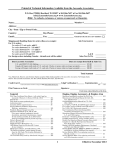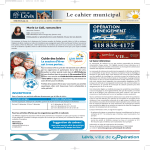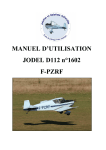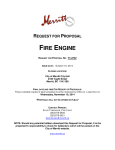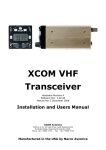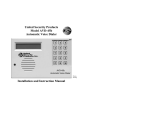Download WHITE BROWN CP 440 Operating instructions
Transcript
ST-440 / ST-640 STEREOCOM Installation Instructions AUTO SQUELCH STEREOCOM INTRODUCTION INSTALLATION FOR COMPLETE SAS-440/640 PLUS RMS-440/640 SYSTEM ATTENTION INSTALLER: To assure a trouble free installation, please read the entire instructions through once before beginning. If just adding a RMS-440 or RMS-640 switcher to an existing SAS installation, proceed to the “INSTALLATION RETROFIT” section on page 5. CONFIGURATION - Sigtronics Auto Squelch Stereocom systems are specifically designed for permanent, panel mounted installation in aircraft. They are configured in two sections: A SAS-440 (4 place) or SAS-640 (6 place) intercom with transmit capability, and a RMS-440 or RMS-640 Stereo Switcher. Both intercom and switcher may be installed at the same time, or the switcher section may be easily added to an existing SAS intercom installation. To upgrade an existing ST-400 or ST-600 installation to a ST-440 or ST-640, skip to the “UPGRADING A ST-400 INSTALLATION TO A ST-440” section on page 5. UPGRADE - An ST-440 or ST-640 can be installed in an existing ST-400 or ST-600 installation by swapping the units out and minimal re-wiring. MUSIC INPUTS - The Stereocom music inputs are fully compatible with music systems that have line level output, headphone level (Walkman) output, or speaker output up to 25 watts per channel. No amplifiers, adapters or modifications to the RMS unit are required. SIZE SAS UNIT - Panel 1” x 2.5”. Chassis - 1” high x 2.5” wide x 6” deep. Can be mounted either horizontally or vertically in the aircraft panel. SIZE RMS UNIT - A 4” x 2.9” x 2” chassis mounted remotely. WEIGHT SAS UNIT - 6.4 ounces (SAS-440 intercom unit with panel and knobs). Jacks and wiring harness weigh 5.5 ounces. WEIGHT RMS UNIT: 7.5 oz. (RMS-440). INPUT POWER - 11VDC through 32VDC. Maximum current drain 0.15 Amp (ST-440). DISTORTION - Less than1%total harmonic distortion. ENVIRONMENTAL - Meets requirements of TSO-C50b. WARRANTY - The ST units are constructed of high quality components and carry a five year parts and labor warranty. For a completely new Stereocom installation follow these instructions: Hardware Supplied Besides the intercom and music switcher unit, each Stereocom system comes with the following hardware: ST-440 ST-640 Headphone Output Jacks - Accept .250” stereo headphone plugs. 4 6 Microphone Input Jacks - Accept standard .206” aircraft microphone plugs. 4 6 Mic Jack Insulation Washers - shoulder and flat. 4 6 SAS Panel: Lettered on both sides for horizontal or vertical mounting. 1 1 Aircraft/Intercom Interface Cable (4 feet long). 1 1 Control Knobs 2 2 Switch Nuts 2 2 SAS Mounting Screws 4-40 2 2 SAS Drill Template (Hole Size Pattern). 1 1 Music Input Cable 1 1 Music Switch Harness 1 1 Music Switch Panel 1 1 Music Input Jack, 3.5 mm 1 1 RMS Mounting Screws 6-32 4 4 RMS Mounting Nuts 6-32 4 4 Specialists in “SOUND” Management 178 East Arrow Highway, San Dimas, CA 91773 ( 909 ) 305-9399 SAS-440/640 CHASSIS INSTALLATION The location selected requires a minimum front panel area of 2 1/2” by 1 1/16”. Depth required behind panel is 6” plus cable access. Allow approximately 1” by 1 1/2” space nearby to mount the music switcher panel. CAUTION: Move aircraft flight controls through limits of travel while observing selected area to make certain intercom components will not interfere with aircraft control components. Panel Preparation: 1. Position the adhesive drill template on the aircraft panel in the selected area. 2. Center punch each hole at cross lines. (The five holes are in a straight line and equally spaced 0.4” apart). 3. Drill a 1/8” pilot hole in all five places. 4. Enlarge one hole to 1/2” and two holes to 3/8” per template. �������� ����� 1. As in mounting the intercom, select a mounting location which will not cause interference with flight controls. (Mount the RMS Switcher unit within 3 feet of the SAS intercom to allow connection of J1 and P1). 2. Remove the four corner (smaller) panel screws and remove the RMS unit from its chassis. 3. Drill four mounting holes in the aircraft with same hole pattern as in the switcher chassis. Use a #27 drill. (Clearance drill for 6-32”) 4. Secure the chassis to the aircraft with the four 6-32 screws and nuts provided. The screw heads should be inside switcher chassis for circuit board clearance. (Care should be taken not to crush grommets while applying torque to screws.) 5. Replace the RMS unit in the chassis and secure. SWITCHER HARNESS INSTALLATION 1. Select an area on the aircraft panel and drill 1/4” diameter holes for the PILOT and PASS. MUSIC ON/OFF Switches. �������� ����� 2. Mount the switches with the bushing key slots down. The PILOTS switch has a WHITE/BROWN wire going to it and mounts on the left. ���� �� ��� ������ ����� ���� RMS-440/640 SWITCHER CHASSIS INSTALLATION ���� � ��� ������ 3. Place the printed switcher panel over the switch bushings and install and tighten the two switch nuts. ���� �������� Figure 1 4. Route the cable harness to the Switcher unit clear of aircraft controls. Secure with suitable wire ties. Mounting Chassis: See Figure 1 1. Remove the knobs from the Volume and OFF/ALL/ISO controls using a 0.050 inch Allen wrench. NOTE: DO NOT REMOVE the nuts from the Volume, Squelch, or OFF/ALL/ISO controls. 2. Insert the SAS unit from rear of the aircraft panel with the appropriate arrow on the unit chassis pointing upwards. 3. Install the printed SAS panel and lightly thread the two 4-40 screws through the holes in intercom panel. The nuts on the Volume and OFF/ALL/ISO controls should fit inside the 3/8” diameter holes. 4. Tighten the two screws. 5. Put the knobs on the Volume (VOL) and OFF/ALL/ISO control shafts and tighten the Allen screws. ��� �������� ������ ���� ��������� ������ ���� ����� ������ ��� ������ ���� �������� ����� Microphone Jack Figure 2 MOUNTING HEADPHONE AND MICROPHONE JACKS 1. Locate the mounting areas. (One mic and one headphone jack required for each headset). 2. Drill 3/8” diameter holes for headphone jacks and install. The terminals on the stereo phone jacks may be identified per the mic jack shown in Figure 2. The phone jack bushings (sleeve terminal) must be grounded to airframe or wired to aircraft ground. page 2 page 3 ��� ��� ��� �������� ������� �� ���� � ���� � ����� � ����� � ���� ������ ����� �� �������� ������ ������ ������ ������� ������ �������� ������ ������ ������ ����� ������ ������ ������ �� ���� � �������� ������� ������ �� ����� �� � �� ��������� ������ Black Brown Red 3 4 6 7 TABLE 1 Blue 2 ������� ���� �� � CONNECT TO: Pilot Transmit Switch (PTT) & Radio Key Input. Switch to Ground to Transmit. Ring Terminal of Hand Mic Jack or Mic Input of Radio or Audio Panel Intercom Circuit Breaker Power Input (12 through 28 VDC) Aircraft Chassis Ground – Central Grounding Point “A” 14 13 11 10 9 8 J2 PIN Tan � ��� � � �� ������ ��� �������� ��� ���� �� �������� ��� ������ ����� ������ � ���� � Ring Terminal of Passenger #1 Mic Jack CONNECT TO: �������� ��������� ���� ������ ���� �� ����� ��� ������ ����� ��� ��� �������� ����� Co-Pilot Mic Input Co-Pilot Transmit Switch Input Ring Terminal of Co-Pilot Mic Jack Co-Pilot Transmit Switch (PTT) * 6 Passenger #4 Mic Input Ring Terminal of Passenger #4 Mic Jack * 6 Passenger #3 Mic Input Ring Terminal of Passenger #3 Mic Jack White / Orange Tan �� �������� ���� ��� ���� ��� ��� ����� ��������� ����� * 6 Passenger #2 Mic Input Ring Terminal of Passenger #2 Mic Jack White / Blue * 8 Tan FUNCTION ��������� � � ������ ��� ��� ���� ����� ��� ���� ���� �� ������ ��� ���� * 6 Passenger #1 Mic Input WIRE COLOR Tan ��� ���� �������� ��������� ���� ��������� ���� ������ ���� ������������� ������������ ������� ��� ���� ������ ��� ������ ��� ������� ������������ ������� ���������� ������ ��������� ������ ����� ������ ����������� ������ ��� ����� ��������� ���� ���� ������ ���� ��� ����������������� ��������� ���� * See corresponding number paragraphs under the “WIRING INSTRUCTIONS” section starting on page 4. *5 ���� ��������� ������� ������ ������ ����� � ��������� � ������ ����� Transmit Mic Audio Output * 4 Intercom Ground ��� ��������� ���� ������ ���� ������ ����� ������ ���� �� ����� �� ��� ����� �� ����� �� ��� ����� ������� ���� ������ ����� ������ ���� Ring Terminal of Pilot Mic Jack �� �� ��� �������� ������� ������� �� ���� �� �������� ����� ���� ����� ��� * 3 Radio Headphone Input Radio Headphone Output Pilot & Radio Transmit White / Red * 8 Switch Input Pilot Mic Input FUNCTION White / Black WIRE COLOR 1 J2 PIN � �������� �� ������ ����� ����� �� �� ������� � ������� ����� �������� ���� �� �� ��� �� �� �� �� ��� ��� ��� ������� �� ������ ���� ��� ������ ������ ������ �� ����� �������� ���� ������� �������� ����� ������ ������� � ������� �������� ��� ������ ������� ������ �� ��������� �� ���� ����� ������ ���� � ���� ������ ��� ����� �������� ����� ������ ��� 3. Drill 1/2” diameter holes for mic jacks and install with insulating washers supplied. (See Figure 2) Note: If the aircraft already has headset jacks (not including the hand mic jack), they can be used for this system, however, any existing wires must be removed and the jacks must be wired as shown in Figure 3. Additionally, if any existing mic jack is mounted in metal, insulating washers must be installed and the barrel connection wired back to Point “A”. channel maximum). Use the Violet, Black, and Orange wires for a Line Level or Headphone Level (Walkman) output. A small stereo panel mount music jack is provided for portable stereo input, if desired. Connect the Violet, Black, and Orange wires to the jacks terminals as shown in Figure 4. Drill a 1/4 inch hole and mount the jack on the aircraft panel. To use, connect an adapter cable between the music input jack and the output of the portable stereo. Suitable cables are available at your local Stereo or electronics store as well as from Sigtronics. WIRING INSTRUCTIONS 1. Connections should be made as shown in Figure 3 and Table 1 on page 3. 2. If longer wire lengths are required, use a good quality hookup wire - 22 gauge or larger. Although not necessary, shielded audio wire can be used if desired. This can simplify the wiring process. 3. The blue wire from J2 Pin 3 must be connected to the aircraft radio headphone output - NOT the speaker output. 4. Connect all intercom mic jack grounds to a single aircraft chassis ground point - Point “A” - as shown in Figure 3. (Use the black washers supplied to insulate the intercom mic jacks from aircraft chassis ground). NOTE: this intercom central grounding point is used to eliminate any unwanted electrical noises, such as alternator whine or strobe noise, from being induced into the intercom system through the grounds. All intercom mic jack barrels must be insulated from ground where they are mounted and connected back to Point “A” on their own individual ground wire. Similarly, both intercom ground wires (J2 pin 4) and the push-to-talk switch grounds must also be connected back to Point “A”. It is not necessary, however, to connect the headphone jack barrels to Point “A”. They can either be grounded where they are mounted or some place nearby. 5. The red wire may be connected to either 12V (14V) or 24V (28V) power source. No switching or adjustments are required to operate from either source. 6. Tan wires (J2 pins 8, 9, 13, and 14) are only used on installations that require extra intercom positions. Tan wires pins 13 and 14 are provided on ST-640 units only. 7. Do not cut and shorten J1 cable. Coil and secure any excess cable. 8. The wires used in the stereo music input cable (J3) depends on the type of stereo used. Use the White/ Violet, White/Brown, Yellow, and White/ Yellow wires for stereos with speaker outputs (25 watts per Figure 4 �������� ����� ��� ��� ������� 9. A Sigtronics Stereocom system can be installed for use with monaural general aviation type headsets. Follow the installation instructions as normal except for the wiring of the stereo headphone jacks. Use the stereo headphone jacks supplied with the Sigtronics Stereo Switcher but leave the “RING” connections open. Connect both headphone wires to the “TIP” of the respective jacks P4 cable GRAY and GREEN for the pilot, and BLUE and WHITE for the copilot and passengers. 10. Make sure any unused wires are properly insulated and kept from shorting to any other wires or aircraft ground. Skip down to the “INSTALLATION CHECK OUT AND ADJUSTMENT” section on page 5. INSTALLATION RETROFIT 1. Mount the RMS switcher chassis per the “RMS-440/640 SWITCHER CHASSIS INSTALLATION” instructions on page 2. 2. Install the PILOT and PASS. MUSIC ON/OFF PILOT/ALL Switches and route the harness per the “SWITCHER HARNESS INSTALLATION” instructions on page 2. 3. Unplug the SAS unit from its wiring harness and insert connectors J1 and P2 on the RMS unit as shown in Figure 3. Connect remaining plugs per Figure 3. 4. Remove the intercom headphone jacks from the pilot, co-pilot, and passenger positions in aircraft. Wires, which had been connected to the phone jacks should be cut, insulated and tied back. If two or more wires appear on a single jack terminal, they should be cut free of the jack, then spliced together before insulating and tying back. Do not disturb the microphone jacks. Replace headphone jacks with three terminal type “stereo” jacks supplied with the RMS switcher. Connect wires to the stereo jacks per Figure 3. Terminals on the stereo phone jacks may be identified per the mic jack shown in Figure 2. The jack bushings (barrel terminal) must be grounded to the airframe or wired to aircraft ground. For monaural operation See Note 9 in the “WIRING INSTRUCTIONS” section above. 5. Connect up stereo music source per Figure 3 and Notes 8 and 10 under the “WIRING INSTRUCTIONS” section above. ���� ������ ������ �������� Skip down to the “INSTALLATION CHECK-OUT AND ADJUSTMENTS” section page 5. page 4 UPGRADING A ST-400 INSTALLATION TO A ST-440 Intercom Chassis Mounting The SAS unit is specifically designed to easily replace a SPA. The panels are exactly the same dimensions (1” x 2.5”), however the SAS units are 1 3/4” longer than the SPA units. Make sure that you have the extra depth required behind your panel. The five mounting holes are exactly in the same positions. Only the center hole will have to be changed (enlarged from 1/4” to 1/2”). To upgrade, first remove the SPA unit from the aircraft panel. This is done by unscrewing the two Phillips head screws and the nut on the ON/OFF switch. Remove the printed SPA panel. Pull the SPA unit out and unplug the white connector from the RES cable. Next, drill the center hole in the aircraft panel out to 1/2”. Then to mount the SAS chassis per the “Mounting Chassis” instructions on page 2. Unplug all four connectors going to the RES switcher unit. Remove the RES unit from its mounting chassis by removing the four corner screws. Remove the RMS switcher unit from its chassis similarly. Put the RMS switcher into the RES chassis and secure. Disconnect the RES music input cable (J3) from the music source and install the RMS input cable per Notes 8 and 10 under “WIRING INSTRUCTIONS” on page 4. Remove the RES switch harness and Panel by removing the two 1/4” nuts on the switch bushings. Disconnect the wires from the intercom stereo headphone jacks. Install the RMS switch harness and Panel per paragraphs 2, 3, and 4 under the “SWITCHERHARNESSINSTALLATION” section on page 2. Rewire all the stereo headphone jacks per Figure 3. INSTALLATION CHECK-OUT AND ADJUSTMENTS After the system is installed, again check that the SAS and RMS unit chassis, jacks, and wiring harnesses are clear of all aircraft operating controls and cause no interference with them. Check out the Stereocom installation by following the instructions: Plug in all the headset mic and phone plugs into the respective intercom jacks. Put on the pilot’s headset and position the boom mic close to the mouth, as is the practice with a hand-held mic. Voice clarity is best when the mic is at one side of the mouth and 1/4” from the lips. the Stereocom system was installed. Aircraft radio reception should be heard in the pilots headset. Aircraft radio reception should not be heard in the co-pilot or passenger headsets. There should be no intercom between headsets with the SAS unit turned “OFF”. Next turn the SAS unit OFF/ALL/ISO switch to the “ALL” position. Set the SAS volume control to mid-position. Verify that all headset positions can now intercom with each other, including the passengers. Verify that both pilot and co-pilot can operate the aircraft radio(s). In this mode all headsets on the intercom will hear the aircraft radio(s). It may be necessary at this time to adjust the SAS unit transmit mic output to the aircraft radios. A small adjustable potentiometer is provided inside the unit for this purpose. It is accessible through a hole in the side of the SAS chassis. It is marked “MOD. ADJ.”, and can be adjusted with a small blade screwdriver. In the event of over-modulation (garbled) or reports of weak transmission’s over the aircraft radio, an appropriate adjustment can be made. Clockwise rotation increases the output level to the aircraft radio mic input. Counter-clockwise rotation decreases modulation level. This adjustment sometimes needs to be made after the initial installation of the intercom or if a new radio is installed. (The output is set for unity gain at Sigtronics). To verify music operation, connect your music source to the music input jack, if applicable. Turn on the music source and set volume to low level. Next turn “ON” the PILOT and PASSenger Stereocom MUSIC ON/OFF switches. When the aircraft radio and intercom are quiet you will hear music in the headsets. Adjust the music source volume to a comfortable level. Verify that music is heard in all headsets and is interrupted by intercom conversations. If everything checks out, refer to the ST-440/ST-640 STEREOCOM OPERATING INSTRUCTIONS for proper use and other operating modes of the Sigtronics Stereocom system. If something does not work as described, carefully go over the system wiring again. If ok, refer to the following section for helpful hints and solutions to common problems: HELPFUL HINTS AND TECHNICAL INFORMATION SAS-440/SAS-640 Sidetone Modification Most aircraft radios, when transmitting, provide what is called “sidetone”. Without sidetone, you will not hear yourself or your co-pilot transmit to ATC. This can be distracting, especially during instruction, because no one on the intercom will hear the outgoing transmission of the radio conversation. Some aircraft radios, however, do not provide this function. Also, some radios are designed to drive only one headset. Therefore, if you have such a radio, the sidetone may be extremely weak or nonexistent. To assure that the aircraft radios, pilot’s headset, and PTT switch are connected and functioning properly, turn the SAS units OFF/ALL/ISO switch to the “OFF” position. Turn the PILOT and PASSenger MUSIC ON/OFF switches “OFF”. If applicable, set the aircraft audio panel to “Headphone” If this is the case and the sidetone cannot be turned up in position. Then turn on the aircraft radio(s) as usual, and the radio(s), a simple modification can be performed within verify that the pilot can hear the radios and can transmit the SAS unit to simulate sidetone. The SAS requires partial using his push-to-talk switch and headset. Aircraft radio(s) disassembly to accomplish this modification. First unplug and and audio panel should operate exactly as they did before remove the SAS unit from the aircraft. To disassemble unit, page 5 Stereo Music Systems Most automotive stereo units operate from 12V-14V sources. Regulators or converters are available to permit operation from 24V-28V sources. ��� ��������� ������ ���� Some FM receivers are capable of causing interference with aircraft COM and NAV receivers. The aircraft panel should be placarded accordingly. Most player only units (cassette or CD) do not cause interference with aircraft receivers. Stereo Headsets Figure 5 carefully remove the four screws securing the bottom cover. Remove the cover to expose the solder side of the circuit board. Solder in an insulated jumper wire as illustrated in Figure 5. Replace the cover and the four screws to complete the modification. With the unit modified in this way, the intercom VOLume control adjusts the level of the sidetone. Additionally, when in “ISO” or “OFF” mode, the SAS unit will not provide sidetone even with this modification. Install the SAS unit into the aircraft panel and plug in the cable. SAS-440/SAS-640 ICS Load Modification This modification is used when a SAS intercom is connected to a radio or audio panel which has a low impedance headphone output (less than 100 ohms). This is most common with some Narco equipment (CP-135,CP-136, and Mark 12D, for example) and “home made” audio select panels. Symptoms are: 1. Intercom audio volume is weak or non-existent when the SAS unit is in “ALL” mode but fine in “ISO” mode and ... 2. Transmit function is normal on aircraft radio and ... Solution: Add a 1/4 or 1/2 watt resistor in-line with the BLUE wire from pin 3 of J2. The value of the resistor most commonly used is 220 ohms, however, optimum performance can be achieved by selecting the value right for your particular installation. The resistor can be any value between 100 and 330 ohms and is selected for the best balance between radio receive volume and intercom volume. 178 East Arrow Highway San Dimas, CA 91773 Phone: (909) 305-9399 E-mail: [email protected] Web Site: www.sigtronics.com Sigtronics stereo headsets are specifically designed for the aircraft high noise environment and give excellent noise attenuation. They also provide full frequency response stereo for maximum enjoyment. They are compatible with aircraft mic circuits and can be used as general aviation headsets in aircraft that are not equipped with stereo headphone jacks. This is because they include a switch to change from “Stereo” to “Monaural”. No adapters required. NOTE: General aviation headset (monaural) phone plugs should not be plugged into Stereocom stereo phone jacks. A monaural plug in a stereo jack shorts out one of the audio channels and therefore renders the aircraft VHF radio and intercom reception inoperative. (You may still here music, however). General aviation headsets may be used only if one of the following three changes are made: 1. Monaural to stereo adapters are used on the headset headphone plugs. (Only monaural music will be heard.) 2. The general aviation headsets are re-wired for stereo reception. 3. Receive function is normal on aircraft radio. Sigtronics Corporation The Sigtronics Stereocom systems are designed for use with general aviation Stereo headsets with high impedance speakers (300 to 600 ohms). Headsets with low impedance (less than 100 ohms) speakers cannot be used with Stereocom systems without modification. Contact Sigtronics for details. In general, headsets with speakers of high and low impedance and/or unmatched audio efficiencies would not be used together without modifications. 3. Install the Sigtronics Stereocom system for monaural operation. See note 9 on page in the “WIRING INSTRUCTIONS” section. If something is still not right or you have any questions regarding the installation and operation of the Sigtronics Stereocom system or any other Sigtronics product feel free to contact us directly. Technicians are available Monday though Friday 8 am to 4:30 pm Pacific time. This concludes the installation check-out. See the separate ST-440/ST-640 STEREOCOM OPERATING INSTRUCTIONS sheet for complete Stereocom operation information. 1-17-2007 page 6 st440ins.pdf






